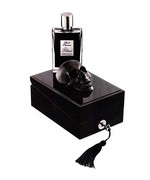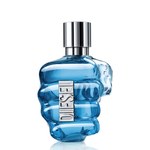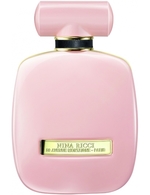Jo Malone English Pear & Freesia (2010): Wanted Rustling Russet Leaves {Fragrance Review & Musings} {New Perfume}
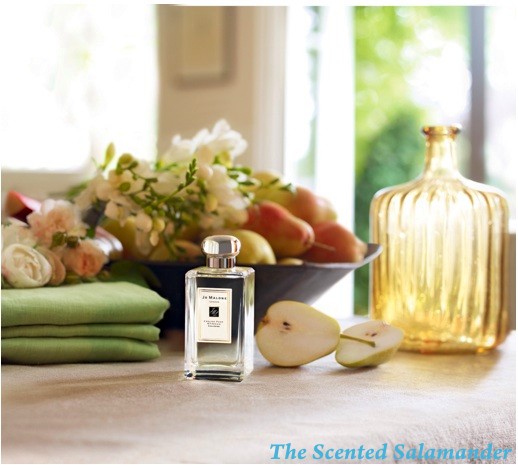
English Pear & Freesia Eau de Parfum by Jo Malone {Fragrance Review & Musings}
The weather has been rather ambiguous this year in Paris, alternating between regular spring and summer and odd bouts of atypical, quirky weather. As we progress into August, again the temperatures seem to hesitate between muggy and hot and cool and autumnal. In the mornings, you can feel an anticipatory atmosphere of crisp fall air with in the background promises of burning fall leaves and mounds of apples. In the afternoons, it still can be sultry inviting you to wear a big moaning tropical floral while you get a chance...
One detail that nevertheless gives away the reality of the fall season fast approaching unless we get a long summer is that one can start hearing crows circling in the sky, which always suggests to me an image of desolate plains with naked, arachnnean trees and abstract grays and whites.
The birds' cries also evoke by thought-association the infamous historical place in Paris where death executions by hanging were carried out for centuries on a hill called Le gibet de Montfaucon. Even in the 19th century when it existed no longer, architect Viollet-Le-Duc felt compelled to draw it on paper with crows flying over the sinister structure which looks like a partly hollowed-out Rubrick's cube with dead bodies swinging in it. Paris, crows, le gibet de Montfaucon is a thought association which can come still fairly easily to Parisians fed on literature and historical graphic novels.
This to say that I have felt the first chills of autumn.
This roundabout preface to say also that the poem which inspired the new perfume Jo Malone English Pear and Freesia to be launched from September 2010, Ode to Autumn by John Keats (see full text below), ends on a particularly evocative stanza "And gathering swallows twitter in the skies." In this just one concluding line, the perceptible atmosphere of fall is put the finishing touches to, prepared beforehand by the rich descriptions of fruits ripening and mellowing. The initial invocation of the poem, "Seasons of mists and mellow fruitfulness!" affirms in one stroke the duality of fall.
The composition signed by perfumer Christine Nagel mostly takes inspiration from the focus that Keats puts on painting the bounty of autumnal fruits leaving aside all explorations of wistful, melancholy notes. While in the poem, apples, grapes, hazelnuts, gourds are evoked, the fragrance concentrates on an autumnal interpretation of a ripe pear note. If the name of the fragrance seems to evoke a fruity-floral, it was also given the stylization of a light chypre.
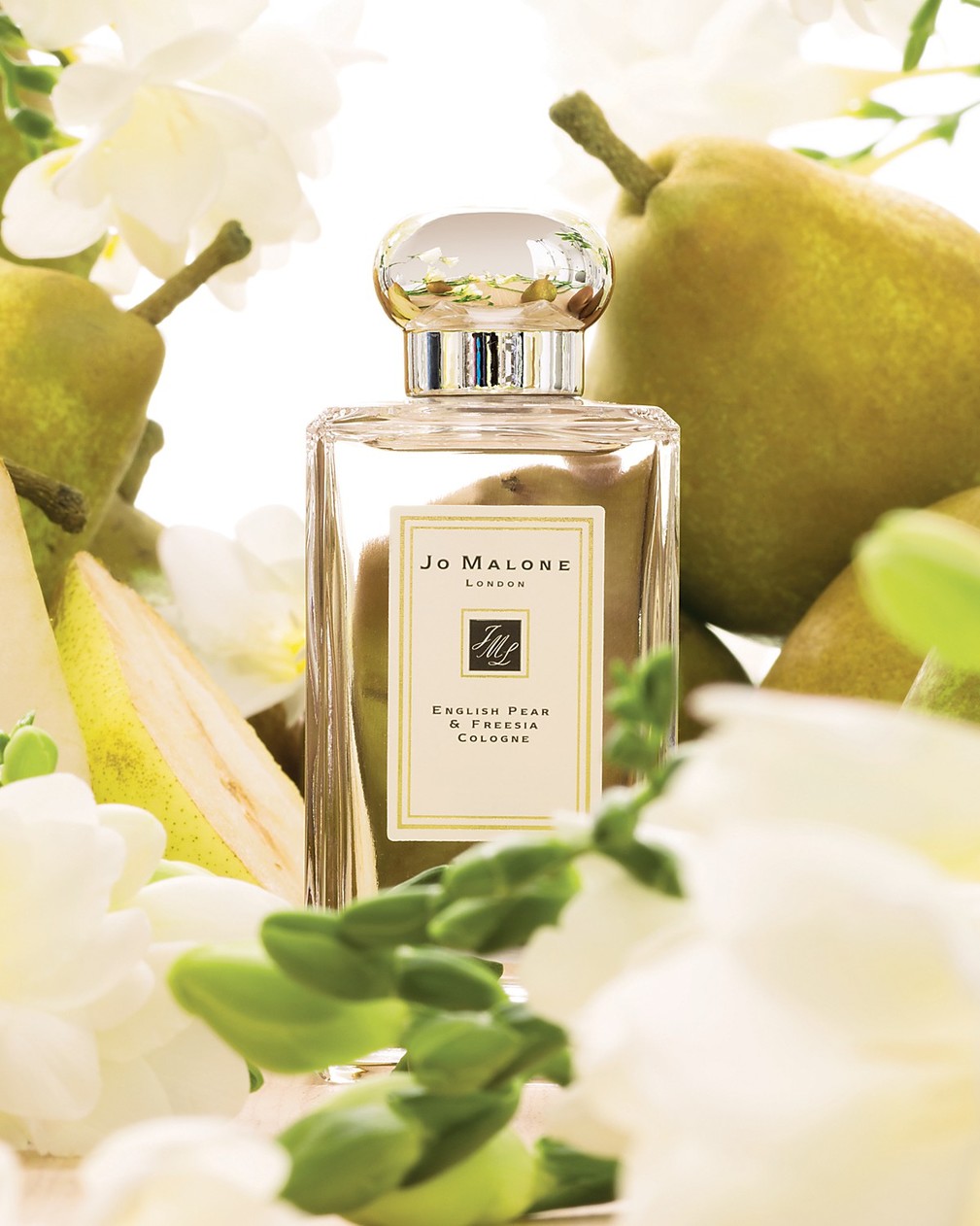
Notes: pear, quince, green rhubarb, white freesias, wild roses, patchouli, white amber, musks
The perfume opens on a very nice impression of woody and fruity pear, with a counterpoint of tart rhubarb. The pear is done in base, darker tones, the color of the leathery skins of some rugose pears, but illustrated in a light chypré style with a noticeable old-fashioned soapy undertone. Some cheese-like indoles are also here like an undercurrent, while the esters-rich composition smells a bit of nail polish remover, a natural facet to certain fruits.
The soap note is characteristic enough to evoke for me the slight suet-like aroma found in Savon de Marseille and further along, I cannot escape the impression of a whimsical play on the meaning of the words "English Pear" as being a wink in the direction of Pear's Soap.
Although I had initially caught a very autumnal quality in the pear accord just by sniffing the scent out of the bottle, the opening notes are much lighter, luminous and evocative of an airy, clean and retro bathroom atmosphere although depending on strength of application the pear note can be deepened significantly.
As the jus progresses, the more stew-y and golden-orange quality of the pear appears. The soapy note recedes. Some salty, ambery and citrusy hints come floating to the surface of one's perception. Perfumer Christine Nagel explained what she wanted to do with the smell of real pear,
"We began by looking at the duality of the pear - the crisp texture of the skin versus the ripe, juicy fruit. You enter the fragrance immediately through the skin, just like when you bite the fresh fruit, and then directly after, the supple juicy pear. The full-bodied pear note is an innovative technical achievement."
It is at this point that the smell reminds me of something vaguely familiar, like the memory of an ambery perfume until I am invited indirectly to remember something else: Pear's soap (this is when it happened in real time.) Now I understand better why there is this initial sensation of a retro cake of soap.
The ambery sensation which triggered my musings finally becomes more precise: it is very close to the smell of the modern neo-chypre Gucci by Gucci, which itself is a descendant of Narciso Rodriguez for Her co-created by perfumers Christine Nagel and Francis Kurkdjian. There is less musk and more amber, but still a rosy-ambery tonality now mingling with the brown, ripe pear.
As the perfume unfolds further, the echoes suggestive of a beautiful and transparent bathroom, in the English toiletry tradition, die away while the notes of sophistication of a fruity-floral chypre get accentuated. The fragrance has become warm like the glow of a fireplace in the fall with a nuance of salty, musky skin.
The pear note, which is more elaborately sketched out than the white freesia one which is here more for effect than figurative illustration, is sugary, evokes pear skin speckled with brown and yellow, and moves from juicy to perfumey. The quince note which is described as "honeyed" sweetens and adds a subtle plummy, stewed and deepening quality to the mix. The blend also lets out a little tartness (green rhubarb), muskiness, and ambery warmth (white amber.) The composition manages to evoke the stillness and quiet of autumn.
Perfumer Christine Nagel re-used some of her personal inspiration put previously in Narciso Rodriguez for Her, further informed here by a twist on the original idea as seen in the fruitier Gucci by Gucci signed by perfumer Ilia Ermenidis (notes of guava and pear, precisely.)
The rose-ambery-patchouli accord which was so popular a couple of years ago, also found in Midnight Poison by Dior for instance, is further popularized here conveying the sense that this is also how a classic gets established: it can be thanks to discreet yet perceptible leitmotiv quotes inserted by the original creator of the accord, and not just by colleagues. But here, we get a combination of both methods which points to the artisanal quality of perfumery based on good recipes and repetitive patterns handed out via a transmission and copying relationship.
While I said in the past that self-referentiality in a perfumer's body of work can be tiring and betray a lack of imagination if it is done too close in time or too repetitiously, still like in a good popular comedy, it is all a question of timing and delivery. Because I was personally able to step back from the tiresome quality of the rose-amber-patchouli accord and also because in fact I appreciate its qualities (I, for example, purchased the Elixir version of Midnight Poison), it introduces curiously in this case already an element of short-span nostalgia as well as a quick identification pathway to the sound of rustling leaves in the fall for all the associations one can have with this ambery accord.
The composition here is slightly soapier as it takes into account the English toiletry heritage of Jo Malone. Some of the house's perfumes are more full-bodied as for instance Dark Amber and Ginger Lily or more recently the Cologne Intense collection (please see Rose Water and Vanilla; Iris and White Musk) but often their scents are English adaptations in the clean floral genre just fresh out of the gardener's shed.
While Nagel insists that "It's unusual for a pear to take centre stage in a fragrance," I cannot really echo this statement without mentioning pear fragrances like Petite Chérie by Annick Goutal (Michael Douglas is a pear guy), Pear by Marc Jacobs, Lola by Marc Jacobs, Gwen Stefani L, Omnia Crystalline by Bulgari or Maybe Baby by Benefit Cosmetics, which all give prominence to the note. It is possible that from the perspective of a professional perfumer nevertheless, a dozen pear perfumes out of hundreds of releases still can make the note feel "unusual," relatively speaking.
The pear itself is one of the deeper and woodier pear notes available on the market, but still with a clean, sudsy facet; the hint of seemingly camphor wood (unlisted) in it adds a touch of cool fall air while accentuating the calm character of the anchoring woods.
The composition begs to be worn during the fall, no doubt about it. It will bloom against the backdrop it was born to embrace: crisp, cool autumnal air with a touch of sorrow and a dab of misty blues, thus perhaps capturing externally the atmospheric element missing in English Pear and Freesia to make it completely and fully autumnal: pleasurable melancholia and veiled wistfulness.
This might be another meaning to add to the fragrance-combining method Jo Malone is known for as they are reputed for conceiving their perfumes as "open works," to use Umberto Eco's literary concept.
Further reading:
Ode to Autumn by John Keats
"Season of mists and mellow fruitfulness!
Close bosom-friend of the maturing sun;
Conspiring with him how to load and bless
With fruit the vines that round the thatch-eaves run;
To bend with apples the mossed cottage-trees,
And fill all fruit with ripeness to the core;
To swell the gourd, and plump the hazel shells
With a sweet kernel; to set budding more,
And still more, later flowers for the bees,
Until they think warm days will never cease,
For Summer has o'erbrimmed their clammy cells.
Who hath not seen thee oft amid thy store?
Sometimes whoever seeks abroad may find
Thee sitting careless on a granary floor,
Thy hair soft-lifted by the winnowing wind;
Or on a half-reaped furrow sound asleep,
Drowsed with the fume of poppies, while thy hook
Spares the next swath and all its twined flowers;
And sometimes like a gleaner thou dost keep
Steady thy laden head across a brook;
Or by a cider-press, with patient look,
Thou watchest the last oozings, hours by hours.
Where are the songs of Spring? Ay, where are they?
Think not of them, thou hast thy music too, -
While barred clouds bloom the soft-dying day
And touch the stubble-plains with rosy hue;
Then in a wailful choir the small gnats mourn
Among the river sallows, borne aloft
Or sinking as the light wind lives or dies;
And full-grown lambs loud bleat from hilly bourn;
Hedge-crickets sing, and now with treble soft
The redbreast whistles from a garden-croft;
And gathering swallows twitter in the skies."







